quondam @ archinect/79/7908y.htm
My Architect on Cinemax
Rita Novel 2004.11.26 09:06
A Party of Renaissance Personalities
[note the exhibit ends 13 February 2005, the quondam feast of Saint Catherine de Ricci.]
Re: of castles, fortifications, etc.
2004.02.13 12:44
Great stuff. I never read any books on symbolism before; I will now, however.
Lots of things zipped through my mind while reading:
castles, Ludwig II, reenactment, Otto in a Schloss (ie, the German for either castle or lock), schizophrenia in a lock-box.
New Jerusalem, Bryn Athyn Cathedral (or Church of the New Jerusalem), Academy of the New Church, Glencairn, Cairnwood -- all local (to me) architecture built with Pitcairn (the local 'Rockefellers') money -- I can't readily go to Bavaria anytime I want, but that's not case with Bryn Athyn, eg, whenever Otto and I go for a ride after dinner on Saturday nights, we travel right through the heart of Bryn Athyn--for a few years now I call it "a little land of reenactment."
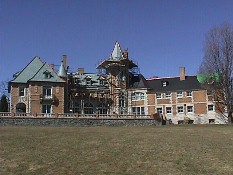 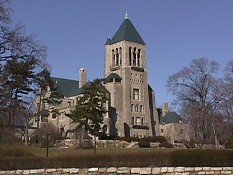 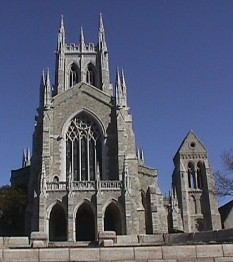
[Bryn Athyn is indeed a true Gothic (constructed) Cathedral in that all the stones are held together with gravity alone, perhaps the only true Gothic Cathedral built entirely in the 20th century. Although still large, it is nonetheless somewhat diminutive in that its scale is something like 2/3rds or 3/5ths the average Gothic Cathedral. The overriding symbolism of this Church goes un-noticed by most--nothing in the design is straight, level or exact; column spacing is always slightly off, all walls slightly bow, there is a slight curve of everything, especially to whatever looks straight. Only God is perfect.
The administration building of the Academy of the New Church is a very early Mitchell/Giurgola building, whose design somewhat reenacts the design of Kahn's unexecuted Goldenberg House, which was to be build on a site just couple miles down from Bryn Athyn.]
Louis Kahn's unexecuted Domincan Motherhouse of St. Catherine de Ricci is chock full of symbolism--today, 13 February, is the feast of St. Catherine de Ricci. I guess I'll visit Elstowe (for the first time) today, and then maybe go take pictures of the castle at the quondam Beaver College.
the Egyptian walls of hieroglyphics and the Berlin Wall of graffiti.
the metabolic urbanism of contemporary Israel.
the secret symbols of Piranesi's Ichnographia Campi Martii.
it is a real joy to still see cedar trees growing in a place long ago called Cedar Grove.
Re: of castles, fortifications, etc.
2004.02.14 14:07
Great stuff, Brian. Mecca and WTC, what a comparison. You seem to be asking (and answering) "how does one design a site of pilgrimage well?" I agree that this is an apt question for design these days. Lucky for me, I suppose, my 'pilgrimage' to the post 9-11 WTC occurred the first weekend Lower Manhattan was reopened after the attack. A true once in a lifetime event. I haven't visited the Pentagon or Shanksville yet, however.
Architect Aldo Rossi also held the lighthouse typology in high regard. If you are not familiar with his many architectural sketches (many of which are published in a fair number of books), you might find lots of inspiration related to your own work. His collecting of favorite typologies is much akin to your own collecting of the 'architecture of electricity'.
Last evening Philadelphia was witness to a great 100' to 150' column of fire. Ten minutes before 5 o'clock a small crew of water workers at the intersection of Olney and Ogontz Avenues (about 2.5 miles directly west from where I live) accidentally broke open a 20" gas main, and within a half minute there erupted an enormous explosion resulting in a tremendously powerful vertical jet of flame. Miraculously, no one was injured, and after four hours the pressure within the gas main was shut off, and the column of fire was gone.
  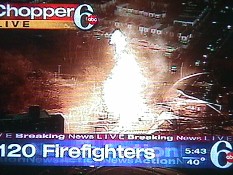
Your thoughts about the place of fiction in the reality of modern life is poignant. Late last night I watched the movie (based on the book) Remains of the Day, and it's story seems to relate to what you say. From amazon.com: "The novel's narrator, Stevens, is a perfect English butler who tries to give his narrow existence form and meaning through the self-effacing, almost mystical practice of his profession. In a career that spans the second World War, Stevens is oblivious of the real life that goes on around him--oblivious, for instance, of the fact that his aristocrat employer is a Nazi sympathizer. Still, there are even larger matters at stake in this heartbreaking, pitch-perfect novel--namely, Stevens' own ability to allow some bit of life-affirming love into his tightly repressed existence." What I saw in the film is that the aristocrat employer was just as oblivious as his butler, an oblivion, moreover, manifest by grandly organized pretense. In the movie, Christopher Reeves plays a U.S. Congressman from Pennsylvania. Before he visits the manor for a circa 1936 foreign affairs conference, the aristocrat and some of his compatriots wonder as to the source of the Congressman's family's wealth--"Perhaps they made their money from trolley cars." This is an obscure reference to the Philadelphia Wideners, for whom Lynnewood Hall by Horace Trumbauer was built. I spent the better part of yesterday afternoon (just across the street from the now derelict Lynnewood Hall, which was once just as grand as the Manor House in the movie) at Our Lady of Prouille, the quondam Elstowe, estate of the Elkins Family, now a retreat house run by the Dominican Sisters of St. Catherine de Ricci. I had the good fortune of speaking with Sister Caroline who is now in charge of the place. We even discussed Louis Kahn's unexecuted design for a Motherhouse which the Sisterhood had commissioned. Before going home, I went to the art library at Temple University's Tyler School of Art (which is right next to where I spoke with Sister Caroline, whose office is within what used to be the estate squash courts). Because I was looking up books about the art treasures that used to be within Lynnewood Hall (now the Widener Collection within the National Gallery, Washington DC), the librarian also brought out of the rare book room a most unexpected item--the 1946 auction catalogue of the estate of Eva Stotesbury. [Gosh, I love the reality of fabricating a novel/fiction.] '
Re: of castles, fortifications, etc.
2004.02.16 11:02
My Architect was not discussed, so I don't know if Sister Caroline saw the movie. What she did was explain why the Motherhouse was commissioned, and how, after repeated redesigns to fit the budget, the project was ultimately abandoned. Sister Caroline was actually more curious about "the paper" Saint Catherine de Ricci and Louis Kahn are to present in "the novel I'm working on." I plan to return to have an extended conversation with Sister Caroline, and perhaps some other Sisters as well. The Dominican Retreat House, just north of Philadelphia, now more or less acts as the Motherhouse of the Dominican Sisters.
I told her I constructed a computer model of the project on the site, and I asked about the big hillside behind where the Motherhouse was to be. She said that was "daffodil hill" because it was covered entirely with daffodils. The Dominican Sisters sold the site (at Media, southwest of Philadelphia, just north of Delaware) in 1990; it is now developed with suburban housing.
The Dominican Retreat House (the quondam Elkins Estate) comprises two Trumbauer Houses, Elstowe and Chelten House--one for the father, one for the son. Elstowe (c. 1900) is in the Italian Renaissance style, with a large powerhouse far down the valley, now a home for aged sisters. Chelten House (c. 1898) is in the Elizabethan style, with a separate stable compound and a squash court. The grounds are quite the sight/site; I look forward to going there again in the Spring. Both mansions are used to house religious retreats every weekend.
[13 February 2005 is the scheduled date of the Saint Catherine de Ricci and Louis I. Kahn presentation of "Reenactionary Bilocation Architecturism", while the Marcel Duchamp and C. Paul Jennewein presentation of "Nudist Camp at the Philadelphia Museum of Art" is set for 20 March 2005. Since Bronzino's PORTRAIT OF COSIMO I DE'MEDICI AS ORPHEUS
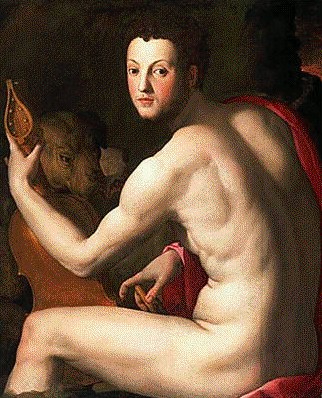
is a key part of "Nudist Camp..." a bilocation of both papers would make a better reality.]
|